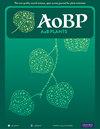The leaf-scale mass-based photosynthetic optimization model better predicts photosynthetic acclimation than the area-based
IF 2.4
3区 生物学
Q2 ECOLOGY
引用次数: 0
Abstract
Background and Aims Leaf-scale photosynthetic optimization models can quantitatively predict photosynthetic acclimation and have become important means of improving vegetation and land surface models. Previous models have generally been based on the optimality assumption of maximizing the net photosynthetic assimilation per unit leaf area (i.e., the area-based optimality), while overlooking other optimality assumption such as maximizing the net photosynthetic assimilation per unit leaf dry mass (i.e., the mass-based optimality). Methods This paper compares the predicted results of photosynthetic acclimation to different environmental conditions between the area-based optimality and the mass-based optimality models. The predictions are then verified using the observational data from the literatures. Key Results The mass-based optimality model better predicted photosynthetic acclimation to growth light intensity, air temperature and CO2 concentration, and captured more variability in photosynthetic traits than the area-based optimality models. Conclusions The findings suggest that the mass-based optimality approach may be a promising strategy for improving the predictive power and accuracy of optimization models, which have been widely used in various studies related to plant carbon issues.基于叶片质量的光合作用优化模型比基于面积的光合作用优化模型能更好地预测光合作用适应性
背景和目的 叶片尺度光合作用优化模型可以定量预测光合适应性,已成为改进植被和地表模型的重要手段。以往的模型一般基于单位叶面积净光合同化最大化(即基于面积的最优化)这一最优化假设,而忽略了其他最优化假设,如单位叶片干质量净光合同化最大化(即基于质量的最优化)。方法 本文比较了基于面积的优化模型和基于质量的优化模型对不同环境条件下光合作用适应性的预测结果。然后利用文献中的观测数据对预测结果进行验证。主要结果 与基于面积的优化模型相比,基于质量的优化模型能更好地预测光合作用对生长光照强度、气温和二氧化碳浓度的适应性,并能捕捉到更多的光合性状变异。结论 研究结果表明,基于质量的优化方法可能是提高优化模型预测能力和准确性的一种有前途的策略。
本文章由计算机程序翻译,如有差异,请以英文原文为准。
求助全文
约1分钟内获得全文
求助全文
来源期刊

AoB Plants
PLANT SCIENCES-
CiteScore
4.80
自引率
0.00%
发文量
54
审稿时长
20 weeks
期刊介绍:
AoB PLANTS is an open-access, online journal that has been publishing peer-reviewed articles since 2010, with an emphasis on all aspects of environmental and evolutionary plant biology. Published by Oxford University Press, this journal is dedicated to rapid publication of research articles, reviews, commentaries and short communications. The taxonomic scope of the journal spans the full gamut of vascular and non-vascular plants, as well as other taxa that impact these organisms. AoB PLANTS provides a fast-track pathway for publishing high-quality research in an open-access environment, where papers are available online to anyone, anywhere free of charge.
 求助内容:
求助内容: 应助结果提醒方式:
应助结果提醒方式:


